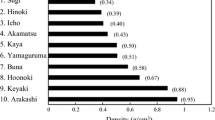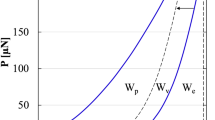Abstract
Mechanical tests on micro-samples were performed in the three material directions in normal, opposite, and tension wood collected from a poplar tree. Two custom micro-devices were designed and built in the laboratory to test samples under pure tension in the transverse direction and under 4-point bending conditions in the longitudinal direction. Both devices were designed to handle samples with a small transverse section (a few square mm), which allowed to select zones with homogenous anatomical features. The results indicate a very high longitudinal stiffness in tension wood (up to 35 GPa compared to an average of 18 GPa for normal wood). Considering wood density, the value represents a specific modulus that is nearly 70 % crystalline cellulose. However, tension wood is slightly less stiff in the tangential and radial directions (1,150 vs. 1,500 MPa for normal wood in the radial direction and 430 vs. 530 MPa in the tangential direction).










Similar content being viewed by others
References
Badel E, Perré P (1999) Determination of the elastic properties in different anatomical elements of oak using tensile tests on micro-samples. Ann For Sci 56:467–478 (in French)
Bergander A, Salmen L (2002) Cell wall properties and their effects on the mechanical properties of fibres. J Mater Sci 37:151–156
Booker RE, Sell J (1998) The nanostructure of the cell wall and its functions in a living tree. Holz Roh-Werkst 56:1–8
Brancheriau L, Bailleres H, Guitard D (2002) Comparison between modulus of elasticity values calculated using 3 and 4 point bending tests on wooden sample. Wood Sci Technol 36:367–383
Butterfield BG (ed) (1998) Microfibril angle in wood. IAWA & IUFRO, Christchurch
Cheng Q, Wang S, Harper DP (2009) Effects of process and source on elastic modulus of single cellulose fibrils evaluated by atomic force microscopy. Compos A 40:583–588
Clair B, Thibaut B, Sugiyama J (2005) On the detachment of the gelatinous layer in tension wood fiber. J Wood Sci 51:218–221
Farruggia F (1998) Determination of the elastic properties of a set of wood fibres from its structural organisation and mechanical tests under a microscope. PhD thesis, ENGREF Nancy, (in French)
Farruggia F, Perré P (2000) Microscopic tensile tests in the transverse plane of earlywood and latewood part of spruce. Wood Sci Technol 34:65–82
Forsberg F, Mooser R, Arnold M, Hack E, Wyss P (2008) 3D Micro-scale deformations of wood in bending: synchrotron radiation μCT data analyzed with digital volume correlation. J Struct Biol 164(2008):255–262
Frank X, Perré P (2010) The potential of meshless methods to address physical and mechanical phenomena involved during drying at the pore level. Dry Technol 28:932–943
Gibson LJ, Ashby MF (1988) Cellular solids—structure and properties. Pergamon Press, Oxford
Gillis P (1972) Orthotropic elastic constants of wood. Wood Sci Technol 6:138–156
Gindl W, Schöberl T (2004) The significance of the elastic modulus of wood cell walls obtained from nanoindentation measurements. Compos Part A 35:1345–1349
Guitard D (1987) Mechanics of wood and composites (in French). Cepadues Editions, Toulouse
Hofstetter K, Hellmich C, Eberhardsteiner J (2005) Development and experimental validation of a continuum micromechanics model for the elasticity of wood. Eur J Mech A Solids 24:1030–1105
Holmberg S, Persson K, Petersson H (1999) Nonlinear mechanical behaviour and analysis of wood and fibre materials. Comput Struct 72:459–489
Jourez B (1997) Tension wood : definition and distribution inside the tree. Biotechnol Agron Soc Environ 1:100–112 (in French)
Jourez B, Riboux A, Leclercq A (2001) Anatomical characteristics of tension wood and opposite wood in young inclined stems of poplar (Populus euramericana CV ‘Ghoy’). IAWA 22:133–157
Keller R (1994) The constitution of wood in wood: an engineering materiel. Ph. Jodin (ed), ARBOLOR, ENGREF Nancy, (in French)
Kollmann FP, Côté WA (1968) Principles of wood science and technology. Volume I: solid wood. Springer, New York
Koponen S, Toratti T, Kanerva P (1991) Modeling longitudinal elastic and shrinkage of wood based on cell structure. Wood Sci Technol 25:25–32
Marchal R, Berthelot A, Reuling D, Aleon A, El Haouzali H, Paillassa E (2009) Wood quality directory of plantation poplar clones. Forêt Privée Française; FCBA; Arts et Métiers ParisTech de Cluny; Chambre Syndicale du Peuplier de France. (in French)
Marhofer RJ, Reiling S, Brickmann J (1996) Computer simulations of crystal structure and elastic properties of cellulose. Ber Bunsenges Phys Chem 100:1350–1354
Nairn JA (2007) Material point method simulations of transverse fracture in wood with realistic morphologies. Holzforschung 61:375–381
Nakai T, Yamamoto H, Nakao T, Hamatake M (2005) Mechanical behavior of the crystalline region of wood and the piezoelectric response of wood in tension tests. Wood Sci Technol 39:163–168
Navi P, Heger F (2005) Thermo-hygro-mechanical behaviour of wood Presses polytechniques et universitaires romandes. CH—1015 Lausanne
Neagu RC, Gamstedt EK (2007) Modelling of effects of ultrastructural morphology on the hygroelastic properties of wood fibres. J Mater Sci 42:10254–10274
Okuyama T, Yamamoto H, Iguchi M, Yoshida M (1990) Generation process of growth stresses in cell walls. II. Growth stress in tension wood. Mokuzai Gakkaishi 36:797–803
Perré P (2002) Wood as a multi-scale porous medium: Observation, Experiment, and Modelling. In: Proceedings of the first international conference of the European Society for wood mechanics, EPFL, Lausanne, Switzerland, pp 365–384
Perré P (2005) MeshPore: a software able to apply image- based meshing techniques to anisotropic and heterogeneous porous media. Dry Technol 23:1993–2006
Perré P (2010) Multiscale modelling of drying as a powerful extension of the macroscopic approach: application to solid wood and biomass processing. Dry Technol 28:944–959
Perré P, Badel E (2003) Properties of oak wood predicted from X-ray inspection: representation, homogenisation and localisation. Part II: computation of macroscopic properties and microscopic stress fields. Ann For Sci 60:247–257
Perré P, Huber F (2007) Measurement of free shrinkage at the tissue level using an optical microscope with an immersion objective: results obtained for Douglas fir (Pseudotsuga menziesii) and spruce (Picea abies). Ann For Sci 64:255–265
Qing H, Mishnaevsky L Jr (2009) 3D Hierarchical computational model of wood as a cellular material with fibril reinforced, heterogeneous multiple layers. Mech Mater 41:1034–1049
Sakudara I, Nukushina Y, Ito T (1962) Experimental determination of the elastic modulus of crystalline regions of oriented polymers. J Polym Sci 57:651–660
Simon P (2009) Multiscale approach of the wood behaviour in its transverse plane. PhD thesis, I.N.S.A Lyon, France
Thibaut B, Gril J, Fournier M (2001) Mechanics of wood and trees: some new highlights for an old story. C R Acad Sci Serie IIb Mec 329:701–716
Watanabe U, Fujita M, Norimoto M (2002) Transverse Young’s Moduli and cell shapes in coniferous early wood. Holzforschung 56:1–6
Yamamoto H (2004) Role of the gelatinous layer on the origin of the physical properties of the tension wood. J Wood Sci 50:197–208
Yamamoto H, Okuyama T, Sugiyama K, Yoshida M (1992) Generation process of growth stresses in cell walls. IV. Action of the cellulose microfibrils upon the generation of the tensile stresses. Mokuzai Gakkaishi 38:107–113
Author information
Authors and Affiliations
Corresponding author
Rights and permissions
About this article
Cite this article
Perre, P., Dinh, A.T., Assor, C. et al. Stiffness of normal, opposite, and tension poplar wood determined using micro-samples in the three material directions. Wood Sci Technol 47, 481–498 (2013). https://doi.org/10.1007/s00226-012-0511-x
Received:
Published:
Issue Date:
DOI: https://doi.org/10.1007/s00226-012-0511-x




